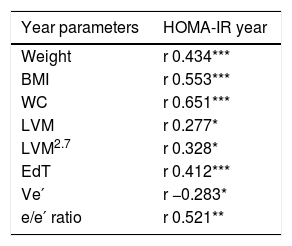Excess weight can cause structural and functional cardiac disorders. The presence of left ventricular hypertrophy in the obese patient is an independent predictor of cardiovascular morbidity and mortality.
The major aim of the present study is to know the prevalence of cardiac morphofunctional disorders in obese patients, before and after weight loss due to bariatric surgery (BS).
Patients and methodsProspective cohort study of 75 patients with obesity without known heart disease referred to gastric bypass. Anthropometric, analytical and echocardiographic parameters were measured before and after 6 and 12 months after BS.
ResultsThe study included 75 patients (66.6% women, mean age 39.3 (9.7) years and BMI 47.8 (7.1) kg/m2). At 6 and 12 months after BS there was a significant reduction in body weight and an improvement in metabolic, inflammatory and prothrombotic parameters and in cardiovascular risk factors associated with obesity (hypertension, type 2 diabetes, dyslipidemia and obstructive sleep apnea-hypopnea syndrome).
Before surgery, cardiac remodelling was present in 62.7%, most frequently in the form of concentric remodelling (38.7%). Diastolic dysfunction occurred in 50.7% of the patients.
One year after surgery, the ventricular pattern was normal in 92% of cases and the diastolic function improved significantly.
ConclusionsOur results support the negative effect of obesity on cardiac geometry and function and the potential reversibility of these cardiac alterations after marked weight loss due to BS.
El exceso de peso puede inducir modificaciones en la estructura y función del miocardio. La presencia de hipertrofia ventricular izquierda es un predictor independiente de morbimortalidad cardiovascular.
El objetivo principal del estudio ha sido conocer la prevalencia de alteraciones morfofuncionales cardiacas en pacientes con obesidad y su modificación tras la pérdida de peso tras cirugía bariátrica (CB).
Pacientes y métodosEstudio de cohortes prospectivo de 75 pacientes con obesidad y sin cardiopatía conocida a los que se les realizó un bypass gástrico. Se midieron parámetros antropométricos, analíticos y ecocardiográficos antes y a los 6 y 12 meses de la intervención.
ResultadosSe incluyeron 75 pacientes (66,6% mujeres, edad media 39,3 (9,7) años e IMC 47,8 (7,1) kg/m2). A los 6 y 12 meses de la CB se produjo una reducción significativa del peso corporal, una mejora en los parámetros metabólicos, inflamatorios y protrombóticos, así como en los factores de riesgo cardiovascular asociados a la obesidad (HTA, DM2, DLP y SAHOS).
Antes de la intervención el 62,7% de los pacientes presentaba alteración en la geometría del ventrículo izquierdo, siendo el remodelado concéntrico la alteración más frecuente (38,7%). Además, el 50,7% presentaba disfunción diastólica. Al año de la CB el patrón ventricular fue normal en el 92% de los casos y la función diastólica mejoró significativamente.
ConclusionesNuestros resultados corroboran el efecto negativo de la obesidad sobre el miocardio, así como la potencial reversibilidad de estas alteraciones tras una pérdida significativa de peso tras CB.












